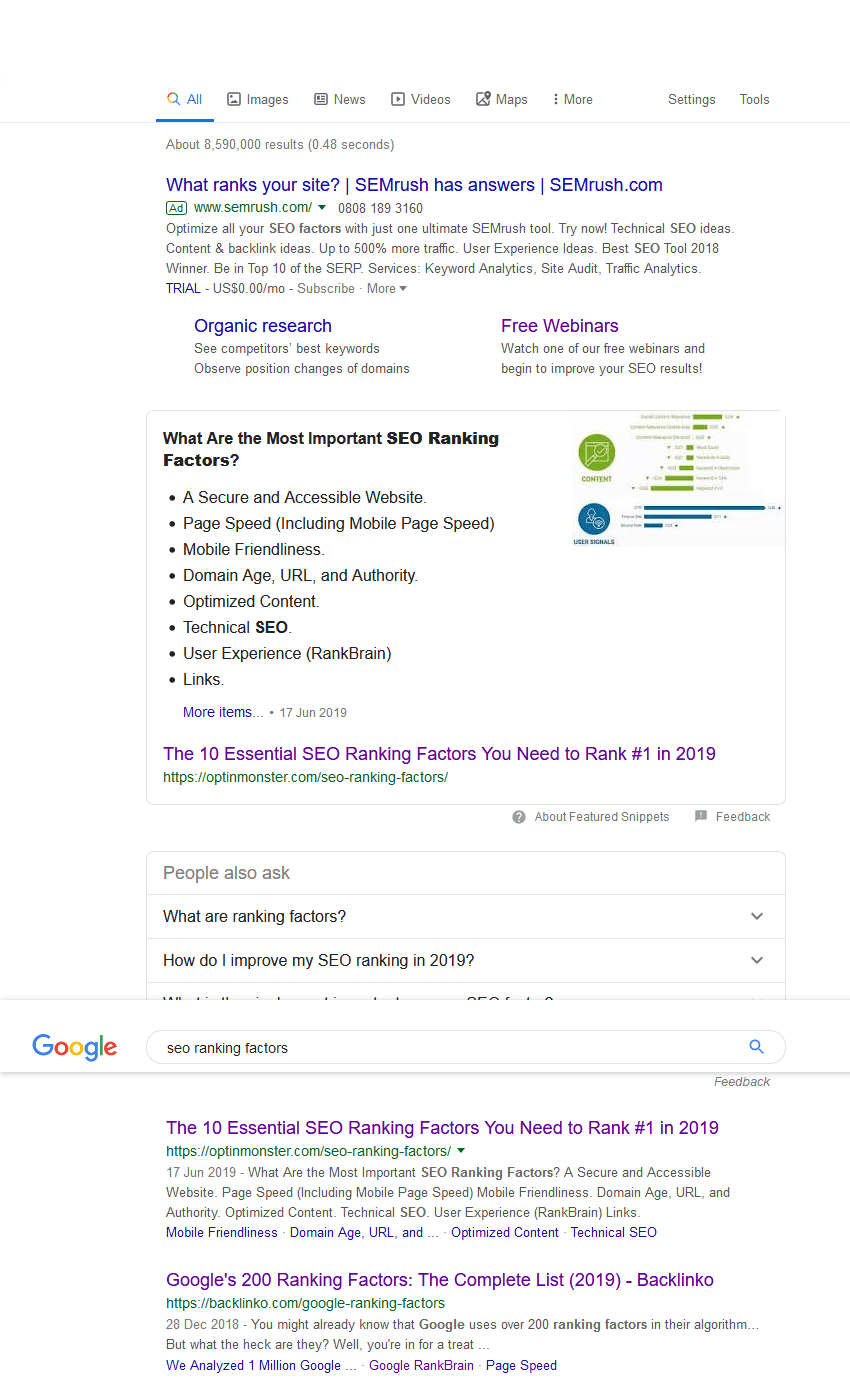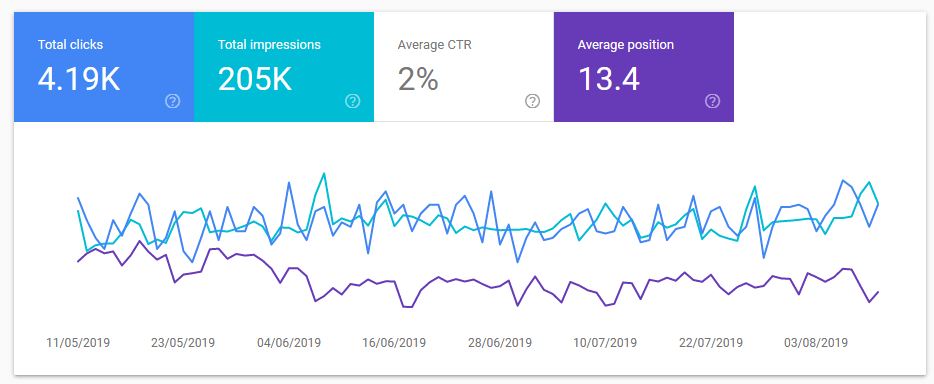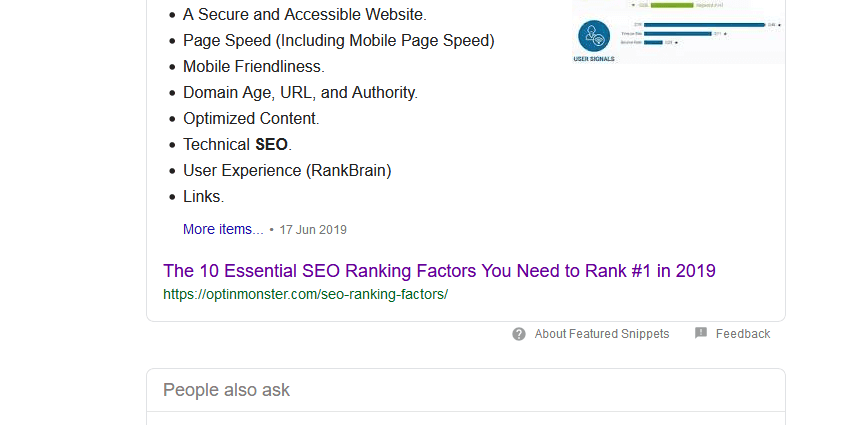Online marketing expert Kevin Indig recently updated his blog post The 10 SEO ranking factors we know to be true.
There is a lot of information around on ranking factors and their importance and the sheer number is often bewildering (between 200 and 500 depending on who you believe) but this blog does a great job in extracting the top 10 with evidence and justification.
What is a SEO ranking factor?
An SEO ranking factor is a signal Google uses to rank pages in Google Search.
When someone types a keyword into Google, search results are presented in the Google Search Results pages – SERPs.
There are often paid search ads at the very top, featured snippets; ‘People also ask’ questions; local search results (the local pack) and finally the 10 first (or page 1) organic search results.
The importance of high search engine rankings
While the organic search results have been bumped down the page over time as Google strives to boost income, being high in search rankings is still important for boosting traffic and income for the website owner.
People do still scroll through search results pages but being featured as high as possible in search results for important keywords is a key objective for any business: the higher the ranking, the higher the Click Through Rate (CTR).
A July 2014 Google organic desktop search study found a 71% CTR for page one results while pages two and three have a combined CTR of just 6%.
We need to work continuously on improving the ranking for our websites as it is a cost-effective way of generating new business and finding new customers.
So while being on page 1 maybe a distant dream for some highly competitive keywords, this shouldn’t stop you trying to boost your rankings.
That means being aware of and improving SEO ranking factors on your website.
Here are the 10 of the most important that have been officially confirmed by Google.
#1 Content
The words used on your website enable Google’s algorithm to figure out what your website is about and who might be interested. This is referred to as ‘Content’.
It helps Google return relevant results to the user that answer their query when they are on a web page.
Content needs to have high relevance for the query, informational depth, answer all questions about a topic and match user intent. So, “Content as a ranking factor” means the length, depth, and relevance of body content for the targeted query.
This means the following:
- Page content
- Meta tags
- Image alt tags
- Page speed
- User experience
Work on improving the quality of your content and you will boost your search engine rankings.
#2 Internal and external links
External links still have an important role to play in rankings but they must be good quality to boost rankings.
Their quality depends on many factors, such as anchor text, strength of the link source, and matching content relevance between link source and target.
Internal links are powerful ranking signals, too. They pass link equity from page to page. Internal anchor text helps Google understand the topic and context of content like external backlinks. Already in 2008, Google recommended to “keep important pages within several clicks from the homepage“. So, URL-structure has a positive impact on rankings because it’s an indicator of a clear hierarchy of information (system taxonomy).
Work on building external links and adding relevant internal links with good quality anchor text.
#3 User intent
User intent is ensuring your website is answering the user’s query.
People either want to buy a product, visit a specific page or find out more about a topic.
Content relevance and User Intent are closely related, but are not the same. First, if user intent isn’t met a page won’t rank, whereas content relevance exists on a spectrum.
#4 Click Through Rate
Click-through rate is the ratio between clicks and impressions in the Google search results. It’s affected by:
- Brand recognition
- Relevance of title, description, and URL for the query
- Whether you have a rich snippet or not
- Other features shown in the SERP (and which ones)
This SEO ranking signal is not 100% established but many in the SEO community believe it is important.
Work on improving the appeal and recognition of your brand (a long term goal), appeal of your title and description tags to encourage clicks.
#5 User experience
This is hard to define but you can boil it down to these three factors:
- Accessibility
- Usability
- Design
Good indicators for User Experience are user signals (bounce rate, dwell time, pages/visit) and engagement signals (social shares, scroll depth).
If a website looks unprofessional, is poorly written and is slow to load then user experience will be poor.
Work on making your website as slick and fast loading as possible with excellent relevant content that can be accessed easily.
#6 Title tag
The Title tag has been one of the stronger ranking signals from the beginning. It’s a strong indicator of relevance and affects CTR. Having the keyword in the title is still a requirement to rank, even though Google understands the context of queries. Google looks at “[…] how often and where those keywords appear on a page, whether in titles or headings or in the body of the text.“
Work on making title tags that reflect the content of the page and are repeated within the content, headings and alt tags.
#7 Page speed
Page speed is has an impact on ranking.
Google’s own page speed tool, WebPageTest, recommends “Speed Index” as unifying metric. It accrues metrics like TTFB (time to first byte), TTFP (time to first paint), TTFMP (time to first meaningful paint), and time to DOMContentLoad to get an overall page score.
#8 Freshness and QDF
“Query deserves freshness” QDF is the ranking signal Amit Signal, former head of search at Google, talked about already in 2007: “The QDF solution revolves around determining whether a topic is “hot”. If news sites or blog posts are actively writing about a topic, the model figures that it is one for which users are more likely to want current information.”
Work on adding topical, relevant content and revisiting and updating old content.
#9 E-A-T (Expertise, Authority, Trustworthiness)
E-A-T (“expertise, authority, trustworthiness”) is another broad signal, like user experience.
To optimize for E-A-T, you need to add information to your site that helps Google understand whether you’re an authority, for example by adding an “about” page or providing a correct and full address.
If your website provides financial advice you need to demonstrate credibility and knowledge of the topic such as membership of associations, relevant qualifications etc.
Google will also look at recommendations and endorsements from other, neutral sites. Yes, that also includes links from highly authoritative sites like Wikipedia.
E-A-T includes factors like domain age, reputation, reviews, and ratings.
Work on – see our earlier blog post Google’s latest push for quality with E-A-T
#10 SSL encryption
Google confirmed SSL being a ranking signal in 2014, after migrating to https itself two years earlier. Once again, the question is and was how much that signal applies.
It’s likely to increase in importance:
“For now it’s only a very lightweight signal—affecting fewer than 1% of global queries, and carrying less weight than other signals such as high-quality content—while we give webmasters time to switch to HTTPS. But over time, we may decide to strengthen it, because we’d like to encourage all website owners to switch from HTTP to HTTPS to keep everyone safe on the web.“
Work on migrating your website to SSL even if you haven’t.
See the original article here: The 10 SEO ranking factors we know to be true.
Get in touch with Dinesh on 07941 686113 if you need help on web design, web hosting, SEO services, domain names or email marketing.
Further reading
The 10 SEO ranking factors we know to be true
How far down the search engine results pages will most people go







